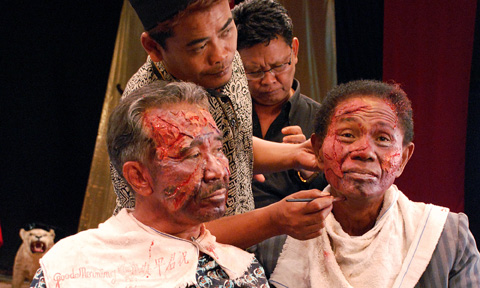
SCENES FROM A RE-CREATION Getting to the truth about genocide, in the perpetrators’ own particular idiom.
|
The ostensible synopsis of Joshua Oppenheimer’s stunning documentary, The Act of Killing, is as simple as it is disturbing: a group of genocidal Indonesian gangsters/government-sanctioned militiamen agree to discuss their crimes if they can do so on their own terms, by stylishly reenacting them in the mode of Hollywood genre films. Two generations beyond their initial rise to power, and still entrenched in the corrupt power structure of northern Sumatra, the murderers intend to commemorate their purge of actual and presumed Communists in a sort of jingoistic cinematic display.
This unnerving conceit turns out to be the film’s most reliable source of humor. One proud gangster, Herman, reveals a jovial tendency to dress in fabulous drag for Western and musical scenes, while the film’s slight but charismatic protagonist, Anwar Congo, colors his hair to reclaim something of his triumphant, badass youth. The duo are a classic odd couple: the former an abiding yes-man (who studies President Obama’s speeches during an ill-fated run for Parliament), and the latter an eerily serene figure best known for innovating an efficient, relatively bloodless technique for committing mass murder on the go.
The hurdles these men run into in their quest to stylishly, yet authentically, reenact their crimes — this impossible compromise is one of many absurdities The Act of Killing lays bare — are performative. In the film’s opening scene, a verdant musical sequence in praise of Anwar Congo set to the tune of “Born Free,” we overhear a director barking at his female dancers: “Natural beauty! This isn’t fake! Peace! Peace!” After they’re instructed to exude grace in honor of a murderer, they shiver and reach for jackets between takes. This is a blunt indication that the performance of power and glory is indeed a performance, and it does little to prepare the viewer for how seemingly uncritically Oppenheimer allows Congo’s memories of murder and cinematic ambitions to transpire. He brilliantly allows Congo and his associates to independently realize they’ve been playing the “gangster” for years, burying the cruelty of their deeds under hollow cant and semantic distinctions. (Man after man insists that the word gangster derives from “free man,” a bit of script as unquestioningly learned as their violent acts.)
The movies, including Oppenheimer’s own, are a constant source of discussion. Congo and some friends started off as “moviehouse gangsters,” and anachronistically claimed they learned their violent techniques from Al Pacino films, and more tenderly recall their euphoria after watching Elvis Presley musicals. An early scene begins as a casting call for Congo’s film and becomes something like an indoctrination, as Herman demonstrates the fear women should exhibit as the militia arrives at their home and then urges his audience to recreate it. It’s a scene dizzying in the blur between performance and reality: a crowd of impoverished, intimidated people lured by the presence of Oppenheimer’s camera to see a show; they are made to become part of the show; their apparent fear of local gangsters yields misplaced but legitimate fear in their impromptu audition. Herman and Congo have found their actors, but through coercive means that are either inadvertent or simply learned behavior. This surreal haze is a consequence of Oppenheimer’s radically transparent acknowledgement of his role in conceiving and capturing such footage — giving war criminals screen time on their own terms — and the viewer’s role in patronizing it. Oppenheimer demonstrates how easily the passive spectator can become an unlikely abettor, and the great cause of his film is to make his actors and audience recognize their moral culpability.